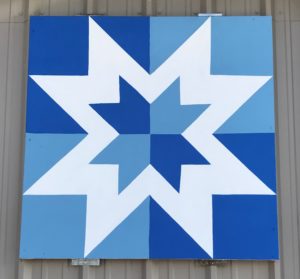
27651 US Highway 65
Western Grove AR
#14-1, Grice’s Star is at 27651 US Highway 65, Western Grove AR. The royal blue and white is a nod to the traditional school colors of Western Grove School. Western Grove is one of three K-12 schools in the Ozark Mountain School District. Grice’s Store is a longtime family business in the area. Owned and managed by Greg Grice, it features full deli, delicious meals, groceries, fuel pumps, and even apparel featuring Buffalo River tees, other local attractions, and Ozark Mountain School Bears regalia. Hot breakfast is available each day until 11am. Grice’s is open seven days a week, rain, snow, or shine and is welcoming to travelers and locals alike. Come take a look at the bright quilt block on the side of our building, then come inside to say hello and get your supplies. This block was painted by two young Latter-day Saint missionaries, Shanaya Deuschle and Ali Nelson, who were serving in Boone and Newton counties in 2020, presented as a gift to the Western Grove community.
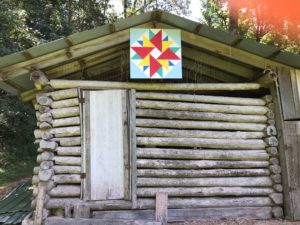
6656 NC 4210
Western Grove AR
#14-2, Double Aster, is one of three quilt blocks at 6656 NC 4210, Western Grove. It’s located on Hersey Road which is an access road to the Buffalo River. Look for it in a field on the left before you arrive at the address. If you will call ahead, owners Garland & Peggy Young, will open the gate for you to get a closer look. 870.416.6702. The Youngs moved to Mt. Hersey in 1992, purchasing a house and 23 acres that join the National Park Service. “We truly love where we live, raised our family, enjoyed the activities of walking, hiking, fishing, swimming, canoeing, hunting, back-roading, 4 wheeling, jeeping, etc. that this area has to offer,” said Peggy. The couple has an overnight guest rental house on the property where the quilt blocks are found. They named the property WoodScape. Its proximity to the Buffalo River, the remote location, being close to nature was something they wanted to share.
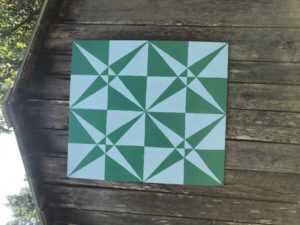
6656 NC 4210
Western Grove AR
#14-3, Crossed Canoes, is one of three blocks found at 6656 NC 4210, Western Grove. It’s a fitting tribute to the canoeists who float the Buffalo River, just one mile away down Mt. Hersey Rd. The Woodscape nightly cabin rental is one mile from the Mt. Hersey access point. It’s a beautiful drive or walk from the cabin to the river. After entering the National Park Service you will see the mouth of a year-round spring called Mitch Hill Spring which runs beside the road emptying into the Buffalo River. Davis Creek also flows into the Buffalo River at Mt. Hersey on the upper side of the access point. This small creek and spring make for an enjoyable adventure for the entire family. The Gene Rush Wild Life Management Area is across from Mt. Hersey and Arkansas Game & Fish has designated areas close to Mt. Hersey.
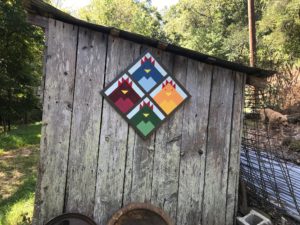
6656 NC 4210
Western Grove AR
#14-4, Hen House, completes the trio of quilt blocks at 6656 NC 4210, Western Grove. It’s a fitting tribute to the many early settlers who depended on the Hen House for their eggs and chicken. Today, there’s a resurgence of raising chickens both on farms and in urban places. A bit of history about Mt. Hersey gathered by Peggy Young: In the 1820’s Nancy and Mitchell Hill initiated the settlement of Mt. Hersey. Frank Mays built a small home in a small hamlet of Mt. Hersey near the mouth of Davis Creek. Mt. Hersey was developed in the 1870’s and by the turn of the century, was a thriving community with a school, post office, and five or six homes. The Mays family operated the local store and post office. The Mays family also operated a grist mill, sawmill, and cotton gin. The Mays house was built about 1915, and the associated outbuildings are the only remaining buildings of the Mt. Hersey community. The privy (outhouse) at the Mays House was likely constructed by the WPA during the 1930’s. The barn west of the house was built about 1915.

19252 AR-123
Jasper AR
#14-5, Eight Point Star, is in the community of Piercetown, at the Newton County Baptist Church at 19252 AR-123, Jasper, AR. Stars are probably the most common motif used on quilts. Homesteaders traveling west used the stars for guidance; and they looked upon stars as religious symbols of their faith in God. (NPS) This block was one of the very first painted in Newton County. It was painted by junior high students from Mount Judea School several years ago when beloved volunteer and retired teacher, Sharon Pierce, who passed away in 2020, first started developing a quilt trail for Newton County. Sharon inspired and guided the students to do the first blocks. About the community: Piercetown was named for early settler Joseph Pierce. Arkansas Encyclopedia shares an interesting tidbit about the community: Jay Smith opened the first airports in the area, one at Piercetown in 1946 and the other in Boone County in 1951.
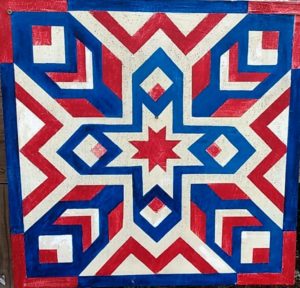
14842 AR-123
Mount Judea AR
#14-6. Student’s Choice, located at 14842 AR-123, Mount Judea, was another early quilt block painted by Mount Judea 7th grade students and re-painted years later to update it. The same students graduated in 2020, so this little class project has been around for awhile. From mtjudea.org, a little information about the town: At 834 feet above sea level, Mt. Judea sits snuggled up against the foot of Kent Mountain at the junction of Arkansas State Highway 123 and State Highway 74, in Newton County, Arkansas. Mt. Judea once was a thriving town that had as many as five stores, a barbershop, blacksmith shop, hotel, doctor’s office, post office, canning factory, sawmill, gristmill, school and a newspaper. Like so many other small towns in this part of Arkansas, many of its inhabitants moved away in order to find work to support their families. Nothing has changed the beauty of the countryside – the craggy bluffs, the beautiful mountains and deep valleys with clear streams of water flowing peacefully through them. Buffalo National River is a scant three miles away.
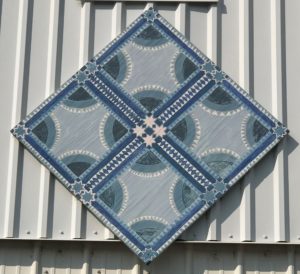
Mount Judea School, AR-123
Mount Judea AR
#14-7, Crown of Thorns, is on the Mount Judea School campus. If you’ve never traveled there, just put the school name into your GPS, as the only address we can find is simply “AR-123.” The block is viewed from the front parking lot. The school has wonderful community support and educates about 180 K-12 students. The school website provides this historical information about Mount Judea School: Mt. Judea’s first school was opened in either the late 1850’s or early 1860’s. It was discontinued for a time during the Civil War, and then reopened in the late 1860’s. Land for the Mt. Judea School was patented from the federal government by Ephraim Greenhaw on March 7, 1860, and the first trustee was his son, Frank M Greenhaw, who served as trustee for 47 years. The school was originally located close to where the old post office was located. It was originally a log building, but it later had a boxed-in room added to the south end of the building. One of the first known teachers during this time period was E.A. Ruble in 1885. In 1897, a new building was built close to where the current high school is located, and the school was moved to the new location. The building was a 2-room frame building, and the up-stairs was used for lodge meetings. Later, a side room was added. In 1912, the first known administrator, A.B. Arbaugh, served as principal. The rock high school building was started in 1935 and finished in 1936 by the WPA. It was the second WPA project that contained President Franklin D Roosevelt’s initials. The building cost $6,000. The two story building was also torn down at this time, and Mt. Judea began teaching high school courses. The first graduates (twins Nielda and Nelda Kent) occurred in 1937. In the early 1940’s many small schools such as Atkinson, Lick Creek, Log Hall, Mt. Home, Ben’s Branch, Bass, Juanita, Dry Creek, Mt. Hecla, Holt, Happy Home, White House, Mt. Hersey, and Carver were consolidated with Mt. Judea. The current white wooden building consisting of 4 rooms and a basement, which became the first cafeteria, was built in the late 1940’s-early 1950’s. Basketball games had previously been played on a dirt court; however, in 1951-52, land located across Highway 123 was purchased from Loyd Hefley and Grover Greenhaw, and the first gymnasium was built. In 1952-53, with Herbert Edwards as coach, the first games were played in the gym. Mt. Judea hosted the first Newton County Tournament that year. In the early 1960’s, the high school building, as well as a bus garage, was built. Then, in 1968, land was purchased from Loyd and Kenneth Hefley, and a new elementary building was started. Dressing rooms and indoor toilets for the gymnasium were also added in 1968. A new lunchroom was built in 1970, and then in 1977-78, new office space was built and more rooms were made available by connecting the high school building and the rock building. In 1980, the lower elementary building and an addition to the gymnasium for bathrooms, dressing rooms, and a concession stand was built. The new gymnasium complex, complete with cafetorium, agriculture shop/classroom, and bus garage, became part of the school campus in 2001. In 2004-05, the Mt. Judea School District and the Deer School District joined to form the current Deer/Mt. Judea School District.
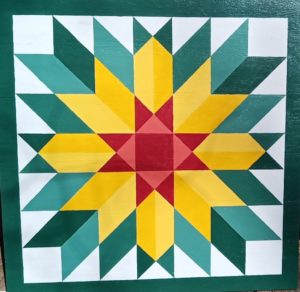
AR-123
Mt. Judea, AR
#14-8, Sunflower, is located at the Mt. Judea Mercantile on AR-123 in Mt. Judea. The Sunflower block is as welcoming as the proprietor, Shelley Tomlinson. The artist is Pearl Harrison, a local college student. The reason she chose the Sunflower pattern is because every year the Mercantile hosts a Sunflower Challenge and provides free seeds to K-12 students from anywhere. The challenge is to grow the biggest sunflower you can. Students deliver the sunflower heads into the mercantile in September for a diameter measurement. Prizes are awarded to the winner. The mercantile season runs April-June and September-Christmas on Friday & Saturday, 10am-4pm and Sundays noon-4pm. It’s a fun destination. The building was constructed sometime in the 1920’s. It has served as a general store, PO, and floral shop & now offers handmade items from around the county! Lots of talented artisans contribute local items to choose from in the historic building. The Mercantile’s succulent homemade fried pies have become the rage for locals and visitors. You’ll be glad you visited this local treasure that more and more people are making the drive to visit.
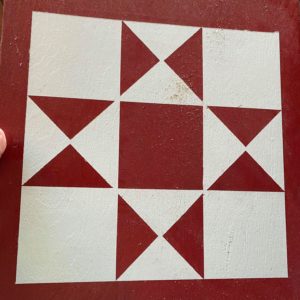
Mt. Judea Lending Library, AR-123
Mt. Judea AR
#14-9, Ohio Star, is a small block on the Mt. Judea Lending Library on AR-123 in Mt. Judea. The location is catty-corner across the street from the Post Office. Painted by Janet Young, the popular pattern adorns the building which was once the Mt. Judea Post Office. Now it is open daily during daylight hours as a library where people can lend and borrow books and materials. The lending library is a project of the Mt. Judea Area Alliance and local residents. MJAA has been involved in numerous beneficial projects for the town over many years.

403 W. Clark St.
Jasper AR
#14-10, Bear Paw, is found on the Chaney Log Cabin on the grounds of the Bradley House Museum at 403 W. Clark St. in Jasper, AR. The Chaney Log Cabin is a two-story double pen log cabin, built in the 1860’s near Osage on the Butterfield Stage Road. One side of the cabin is open and displaying items that might have been found in a cabin of this age. The other side is currently not open, but plans include placing farming and blacksmith objects inside it. Exhibits include items such as: rope bed, spinning wheel, quilting frame, table. Outdoor exhibits include: Horse drawn road grader, circa 1896; Water well; Herb Garden which was started by the Jasper Master Gardeners; Smoke House and Outdoor Fire Pit. The Bradley House Museum and the grounds including the Chaney Log Cabin are operated by the Newton County Historical Society, a 501(c)(3) organization.
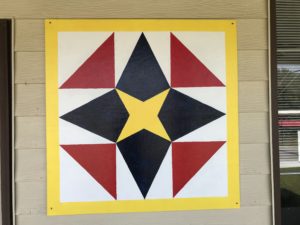
403 W. Clark St.
Jasper AR
#14-11, Arkansas State block, is on the front porch of the Bradley House Museum at 403 W. Clark St., Jasper AR. The Bradley House was once the home of Dr. and Mrs. W.A. Bradley. Dr. Bradley had his office downstairs, and the family lived in the other parts of the house. The museum includes rooms with exhibits: The Doctor’s Office, Front Room, Kitchen, Tool Room, School/Community Room, Natural-Early History Room, Entry, Upstairs Hall, and the Research Room. A variety of information can be found in the research room consisting of past items such as newsletters from Newton County and other neighboring counties, books, photographs, newspapers, school records, county records, and church records. Also a large number of books in the downstairs office. The Newton County Historical Society is a non-profit organization dedicated to the preservation of the historical heritage of Newton County, Arkansas. The Society operates the Bradley House Museum (consisting of the Bradley House and the Chaney Log Cabin). It is located at 403 Clark Street in Jasper, Arkansas. The museum is closed January-February. It is open 10:30-4:30 Wednesday-Friday during mid March-October and on Wednesday only during November and December. During the summer, the museum is also open on the 1st and 3rd Saturdays. Admission is free; however, a $3 donation per person is appreciated.
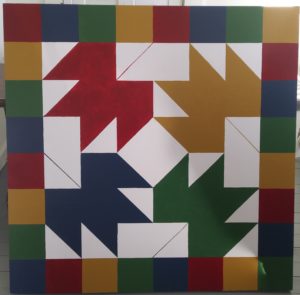
Bradley Park-Clark Street
Jasper AR
#14-12, Autumn Splendor, is found at the Bradley Park, Jasper AR. It is sponsored by the City of Jasper. Located along the Little Buffalo River at the end of Clark Street, this city owned park has something to offer everyone. The newly completed walking trail follows the Little Buffalo River and leads to especially beautiful places for contemplation, as well as excellent fishing and swimming holes. The bend of the river was frequently used by local churches in early days for baptisms and on special occasions, still is. There’s a rock at river’s edge by a leaning tree where water dripping down the cliff on the other side plays wonderful melodies to anyone quiet enough to listen. The athletic minded enjoy newly constructed tennis and basketball courts. Bradley Park hosts the Jasper Summer Baseball Program, where over 100 local boys and girls ages five to twelve compete on the park’s two newly fenced softball and baseball fields. Vaughn Pavilion, centrally located in the park, covers 10 full size picnic tables. Electricity is available upon request. The full size BBQ pit and buffet table make this the perfect place for reunions. For more information call 446-5217. To plan your trip to Newton County, start here. https://www.theozarkmountains.com/

230 S. Stone St.
Jasper AR
#14-13. Cats and Friends, is at the Newton County Library at 230 S. Stone St., Jasper AR. The block is mounted on the northeast side of the building, to the right of the portico, and faces Highway 7. It can be viewed by pulling into the library’s parking lot. The Cats and Friends block design was selected by library director Kenya Windel and NCL’s Board of Trustees. The Cats and Friends quilt trail block was drawn by Quinnell Land and painted by Debralee Alexander. A mini-quilt wall hanging of the same design, the inspiration for this quilt trail block, was made by local quilter Rose Szabrowicz and donated to the library by long-time Friends of the Library member Betty Stivers. The mini-quilt hangs above the circulation desk just inside the library entrance. NCL chose the Cats and Friends design in honor of our library cat Pepper and our Friends of the Library organization. The Friends of the Library is NCL’s official fundraising and volunteer group. The design also pays homage to our many community friends who use, support, and advocate for NCL and other public libraries. For NCL, the quilt block represents the age-old connection between libraries, readers, and cats and the appreciation we feel toward our community—our friends. Pepper was adopted by NCL in June 2019, after she, her mother, and her litter mates were abandoned near the library. All members of the cat family found homes. Pepper has many friends and admirers who visit her at the library, and she provides both companionship and pest control at NCL. Pepper herself is a reminder that stray and abandoned animals need friends to care and advocate for them, and they need organizations and volunteers to provide low-cost sterilization, veterinary services, and other assistance. Pepper is largely supported by community donations. The Newton County Library has operated at its current location since November 1994, when the county’s garage and shop building was converted into the county’s public library. The Friends of the Library raised the funds and did a good deal of the physical labor required to transform the building from a utilitarian concrete block structure to a charming, cypress-sided public library. The library grounds are also home to the Gould Jones Reservoir, listed on the National Register of Historic Places. The Gould Jones Reservoir is the round building located on the southeast side of the parking lot. Built in 1946, by local builder Gould Jones, the reservoir provided water to a tomato canning factory and was the first public water system to supply the town of Jasper. Visitors are welcome to the Newton County Library!
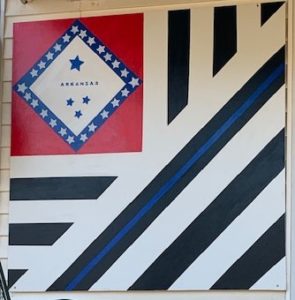
601 W. Clark St.
Jasper AR
#14-14, Back the Blue in AR is at 601 W. Clark St. Jasper AR. It was chosen to honor local law enforcement officers who put their life on the line each and every day for the citizens of Newton County. In a “Walks through History” tour presented by Arkansas Historic Preservation Program, Rachel Silva shared the following: Newton County was created in 1842 from part of Carroll County. By the early 1840s, Jasper was established as a trading post along the Little Buffalo River, then known as Hudson’s Fork of the Buffalo River. Jasper became the Newton County seat in 1843. The origin of the town’s name is uncertain, but one popular story says that postmaster John M. Ross picked the name after comparing a local rock formation to jasper, one of twelve precious stones referred to in the Book of Revelation. Jasper became a boomtown in the late nineteenth century as a result of the timber industry. Sawmills processed the area’s plentiful oak and cedar trees (used to make stave bolts for barrels as well as pencils) and employed hundreds of men. The Jasper Commercial Historic District is anchored by the WPA-built Newton County Courthouse and features several distinctive rough-cut stone buildings. Because of its location near the Buffalo National River, Jasper’s economy relies heavily on tourism. Outdoor enthusiasts and elk watchers visit the town each year. Interesting facts—Arkansas contributed a stone for the Washington Monument, and it came from near present-day Marble Falls in Newton County. Newton County’s population in 1900 was about 12,500, but it is currently only 8,500. Newton County has never had a mile of railroad track constructed through it, and there are no stoplights in the county either.
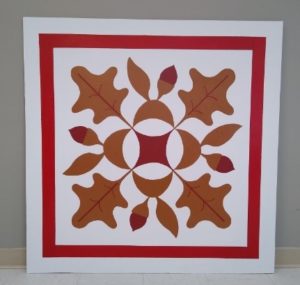
100 E. Clark St.
Jasper AR
#14-15, Oak Leaf Cluster, is at the Newton County Senior Activity & Wellness Center at 100 E. Clark St., Jasper AR. The block is on the Highway 7 side of the building. It was painted by Tim McSweeney. The center is part of The Area Agency on Aging of Northwest Arkansas. Hours are 8am-4:30pm, Monday-Friday. A delicious and healthy lunch is provided daily. Group activities and games are available. Check our monthly calendar at https://www.aaanwar.org/locations/detail/1434
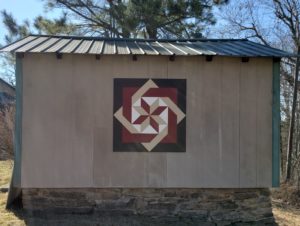
421 NC 8500
Deer AR
#14-16, Star Maze, is located at 421 NC 8500, Deer. This property, often referred to as the “Floyd (Froggie) Daniels Place” or “Ertle Glen and Velma’s”, is now owned by Ben and Kim Gear of Kansas City. Kim grew up traveling to Newton County often to visit family, including her grandmothers, Gerene Willis and Pearl Ammons, and numerous aunts, uncles and cousins. Ben and Kim now enjoy it as a place to relax and enjoy the peace and quiet it offers. When Ben and Kim purchased the property in 2012, one of the first big projects they completed was replacing the roof and painting the barn. With a nod to previous owners, Ertle Glen and Velma Casey, Kim painted numbers down the sides of the building. At one time, the Caseys used it as a hog barn, and the numbers (along with small doors underneath) helped to sort pig litters. The Gear’s barn quilt projects grew from the desire to have something to do during the snowy 2021 New Year’s Day weekend, and has kind of taken on a life of its own. Several have been gifted to family, and Ben is always on the lookout for new ideas. The Star Maze, located on the side of the tool shed near the road, was quite a challenge with its “optical illusion” frame, and his choice of the bold black, red, tan and white makes the pattern really stand out. You’ll get a bonus quilt block at this location. The Maple Leaf was their first barn quilt. The pattern was chosen because they have a maple leaf quilt that was made by members of the Wayton community. Kim believes it was a wedding gift for her parents a little over 60 years ago. Since we have an exact duplicate of this pattern already on the Newton County trail, the Gear’s version is our bonus block!
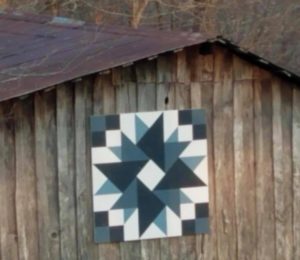
785 NC 8500
Deer AR
#14-17, Dutch Windmill, is at 785 NC 8500, Deer AR. Both of Kim Gear’s grandmothers were talented quilters, and she recalls Gerene, or “Nanny” as her grandchildren (and the Wayton community) called her, having quilt frames attached to the ceiling in a room of her house that could be lowered to work on projects, and raised to be out of the way at other times. Nanny hosted “quiltings” at her house a lot; members of the Wayton community would each piece or applique a block, write their names on them, then the blocks would be assembled and quilted to give as gifts to seniors graduating from Deer High School. Kim and her brothers were also presented with these quilts, and they are treasured still. The Dutch Windmill quilt is located just down the road from Ben and Kim’s place at 785 NC 8500. It’s placed on the north side of the tool shed, and can be seen from the road. This property belongs to Monte and Lisa Willis. Monte is Kim’s brother, and Lisa is the granddaughter of Floyd “Froggie” Daniels, one of the previous owners of the Gear’s property.

#14-18, Fishers Among Men, 504 West Court St., Jasper AR. The Newton County Food Room chose a quilt design with a cross to represent the Christian. More importantly, they chose the fish to reflect the proverb “Give a man a fish, he eats for a day. Teach a man to fish, he never goes hungry.” The Christian Food Room is supported by many of the Newton County area churches. They pray no one goes hungry.
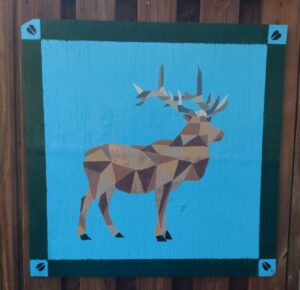
4642 AR 43 Hwy
Ponca AR
#14-19, Wapiti, is located at the Ponca Nature Center at 4642 AR 43 Highway, Ponca, AR. Find two quilt blocks on the restrooms at the picnic area. American Indians called elk “Wapiti,” which means “white rump” in Shawnee. Eastern elk once roamed most of Arkansas. Settlement and exploitation by early immigrants reduced the population, and no reliable records exist of Arkansas elk later than the 1840s. The first elk restoration attempt in Arkansas was in 1933 when the US Forest Service stocked 11 elk in Franklin County. The herd increased to an estimated 200 animals by the mid-1950s, but then disappeared. Illegal hunting, natural mortality and loss of suitable habitat possibly exterminated this herd. The Arkansas Game and Fish Commission began a second restoration effort between 1981 and 1985. The AGFC, in cooperation with citizens of Newton County, stocked 112 elk near the Buffalo National River. This herd has increased to as many as around 700 animals, but typically stays around the 500 animal mark. Arkansas’ elk range consists of over 350,000 acres in the northwestern part of the state. Most elk are in Newton and Searcy counties with a few found in Boone, Carroll, and Madison counties. Arkansas’ first elk hunting season was in 1998. Hunting is by permit only, and is very limited. Elk viewing and hunting are both major draws to this part of the state. Boxley Valley has fantastic elk viewing opportunities, and at a visit to the Ponca Nature Center, the visitor will receive a map and an idea of the best areas to look.
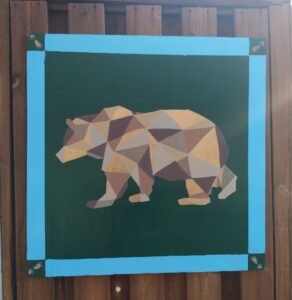
4642 AR 43 Hwy
Ponca AR
#14-20, Walking Bear, is located at the Ponca Nature Center at 4642 AR 43 Highway, Ponca, AR. Find two quilt blocks on the restrooms at the picnic area. Arkansas was once known as the Bear State. However, by the 1930s, black bears were almost hunted completely out of the state. Beginning in 1958, the Arkansas Game and Fish Commission reintroduced 254 black bears into the state, and today, there are over 5,000 bears across Arkansas. This reintroduction effort is recognized as the most successful reintroduction of a large carnivore in history. It was so successful that a hunting season for black bears began in 1980. Arkansas black bears do not truly hibernate, although they go into a deep sleep during part of winter, they can wake up from their sleep if needed. Their diet is made of up to 90% fruits, berries, twigs and grasses. The rest is typically made up of insects. They usually have very little meat in their diet, but are opportunistic if they come across a dead animal. Female black bears usually begin reproducing at age 3-4, and can have cubs until they are around 20 years old. While that gives them 16 years of opportunity to reproduce, they will only have cubs on an every other year cycle.
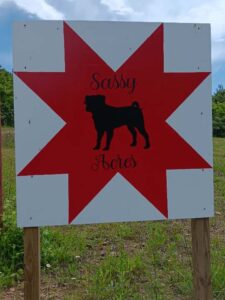
15774 AR Hwy 16
Deer AR
#14-21, Sassy Acres, is at 15774 AR Hwy 16, Deer, Arkansas. Mary Quincey’s first ever pug was named Sassy and she discovered the meaning of a “heart dog.” Sassy’s personality mirrored Mary’s so that it endeared this pet to Mary forever and making her an obsessed pug “mom.” All her dogs have been pugs since and are such loving companions. Mary is a Quilter, all around crafter and enjoys baking. Unfortunately Sassy did not make it to her Mom’s dream place to live here in Arkansas due to her advanced age. A friend in Limestone Valley made the quilt block for Mary so her home could be dedicated to her first pug “love.” All items made are made with Sassy love.
These are all amazing and I love the stories. Had seen some during our vacations in Arksansas but did know anything about them till now. Thank you!
So glad you you enjoyed the stories and seeing some of the barn quilts in Arkansas!